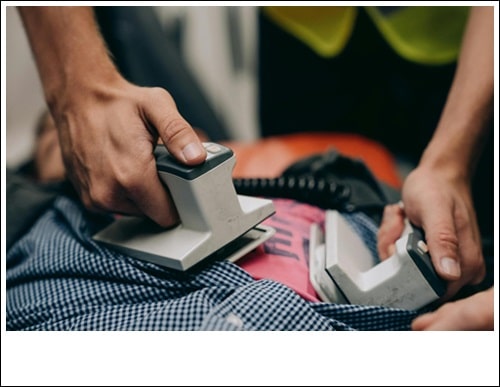
You may have seen briefcase-sized devices mounted on the wall in your gym or workplace lobby. These devices are often in a bright red or yellow case and clearly marked with a heart and lightning bolt symbol. They are automated external defibrillators (AEDs) and they are designed to save lives. Inside each case, you will find electrode pads powered by a special automated external defibrillator battery that can shock a failing heart back into a normal rhythm. This article will explain how AEDs work and why they are placed in public places around the country.
What Is Sudden Cardiac Arrest?
Sudden cardiac arrest (SCA) is one of the leading causes of death in the United States. Unlike a heart attack, which is triggered by a blockage that reduces blood flow, sudden cardiac arrest occurs when the heart’s electrical system malfunctions, causing it to stop beating properly.
In these situations, immediate intervention is critical as survival rates drop drastically for each minute that passes without treatment. Sudden cardiac arrest can happen to any person, regardless of age or health status, making it impossible to predict.
How Does an AED Work?
An AED is a portable tool that can analyze the heart’s rhythm and deliver an electric shock (if needed) to help the heart reestablish an effective rhythm. AEDs are designed to be easy to use so even individuals with no medical training can employ them in an emergency. The device is programmed with simple voice prompts that guide the user through the entire process, from turning it on to applying the electrode pads.
Time is critical when someone experiences SCA. While cardiopulmonary resuscitation (CPR) can help keep oxygen flowing to the brain and vital organs, only a defibrillator can reset the heart’s rhythm. CPR and AEDs work best together. In other words, CPR can buy the patient time, while the AED can restart the heart and get it beating normally again.
According to the American Heart Association, using an AED within the first two minutes of a cardiac arrest can increase the chance of survival by up to 70%. Unfortunately, despite increased availability, AEDs are not always used in emergencies. In many cases, bystanders may not know where an AED is located or may hesitate to use it due to lack of training.
AED Access in the United States
To improve AED accessibility and encourage bystander use, many states have enacted laws that address the availability and legal liability associated with AEDs.
AED Placement Laws
Most states in the US require AEDs to be installed in specific locations where the risk of SCA may be higher—due to large crowds or physical activity. Common examples include schools, fitness centers, government buildings, and airports. Large public venues such as stadiums, casinos, and convention centers may also be required to have AEDs on-site due to the sheer number of people they host during events.
In some jurisdictions, AEDs are required in large office buildings, shopping malls, and theme parks, where high visitor volume and long distances from medical facilities can delay emergency response. These laws are designed to increase the likelihood that a defibrillator is within reach during a cardiac emergency. By strategically placing AEDs in busy or high-risk areas, states aim to potentially save lives before emergency medical services (EMS) arrive.
Good Samaritan Laws
Every US state has enacted some form of Good Samaritan law to encourage bystanders to help in medical emergencies. These laws are especially important when it comes to using an AED, as many people hesitate to act out of fear they might cause harm or be held liable. Good Samaritan laws typically provide civil immunity to individuals who use an AED in good faith during a sudden cardiac arrest emergency, even if they are not medical professionals.
In addition to protecting individual bystanders, some state laws also extend liability protection to businesses, schools, and organizations that purchase and maintain AEDs for public use. These protections may apply if the AED is properly maintained and used in accordance with state guidelines. For instance, a gym that installs an AED and provides basic staff training may be shielded from legal claims.
Maintenance and Registration Requirements
In US states where AEDs are mandated, laws often require owners to maintain the device in good working order. AEDs are powered by special batteries that typically have a shelf life of two to five years. These batteries must be regularly monitored and replaced as needed to ensure the device remains ready for use. The electrode pads also have a limited shelf life because the gel that helps them adhere to the skin can dry out over time.
Additionally, AEDs may be required to be registered with local EMS. Some states also require training for certain groups, such as school personnel, fitness instructors, or designated emergency responders. Courses are often provided by organizations like the American Red Cross and the American Heart Association, and they typically include both CPR and AED instruction.
Continuing to Save Lives
AEDs are a vital tool for responding to sudden cardiac arrest. Given their portability, ease of use, and life-saving potential, AEDs are becoming more and more common in public places. There are now even smartphone apps that can help you locate the closest AEDs in an emergency. While we cannot prevent or predict the onset of SCA, we can better prepare to save the lives of cardiac arrest victims by increasing public access to AEDs
Leave a Reply
You must be logged in to post a comment.